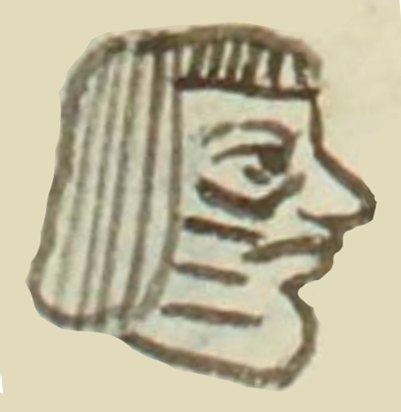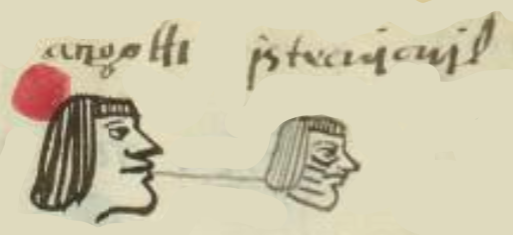Iztecuicuil (MH830r)
This black-line drawing of the simplex glyph for the personal name Iztecuicuil (perhaps “Scratched/Scarred”) is attested here as a man’s name. The glyph shows a man’s head in a profile view, facing the viewer’s right. Four horizontal lines have been added to his visible cheek. These appear to be scratch marks. The gloss includes the element of a fingernail (iztetl) and the verb to scratch (iztecui). But the -cuil ending deserves some special attention, as the verb cuicuil and its derivatives suggest the writing/painting or making of designs. Thus, the -cuil part might refer to making (lasting) markings on the cheek.
Stephanie Wood
Marc Thouvenot identifies the verb icuiloa (or ihcuiloa, with the glottal stop), which means to paint, write, or print, as having a root of -cuil-. He notes how it also appears in tlacuiloliztli (writing), tlacuilo (writer), and cuicuiltic (mottled). He goes on to show various uses of icuiloa that take it beyond the simple definitions just given, resulting in something like the action of creating a design (e.g., on leather, ceramics, sculpture, or in textiles). It can also be something like the action of decorating (e.g., to put a flower on a cup of atole). He associates icuiloa and tlacuilolli with "cultural artifacts," such as arts and crafts or examples of writing and painting, but cuicuiltic with effects created by "nature." This short summary barely does his article justice; it is worth reading the entire piece. How Thouvenot's study might connect with the concept of bent or curved mentioned by Prem (1974: 555, 682) raises an interesting question. Perhaps the bent or curved lines of writing, painting, carving, embroidery, and so on, fall with in the realm of expressions of -cuil-. See
Marc Thouvenot, "Imágenes y escritura entre los nahuas del inicio del XVI," Estudios de Cultural Náhuatl 41 (2010).
Stephanie Wood
angosti iztecuicuil
Agustín Iztecuicuil
Stephanie Wood
1560
Jeff Haskett-Wood
uñas, rayar, rascar, nombres de hombres

izte(tl), fingernail, https://nahuatl.wired-humanities.org/content/iztetl
Iztecui, to scratch or pinch, https://nahuatl.wired-humanities.org/content/iztecui
cuicuiltic, painted, spotted, varicolored, https://nahuatl.wired-humanities.org/content/cuicuiltic
cuicuiloa, to paint something many colors, https://nahuatl.wired-humanities.org/content/cu%C4%ABcu%C4%ABlo%C4%81
Rayado
Stephanie Wood
Matrícula de Huexotzinco, folio 830r, World Digital Library, https://www.loc.gov/resource/gdcwdl.wdl_15282/?sp=734&st=image.
This manuscript is hosted by the Library of Congress and the World Digital Library; used here with the Creative Commons, “Attribution-NonCommercial-ShareAlike 3.0 License” (CC-BY-NC-SAq 3.0).






